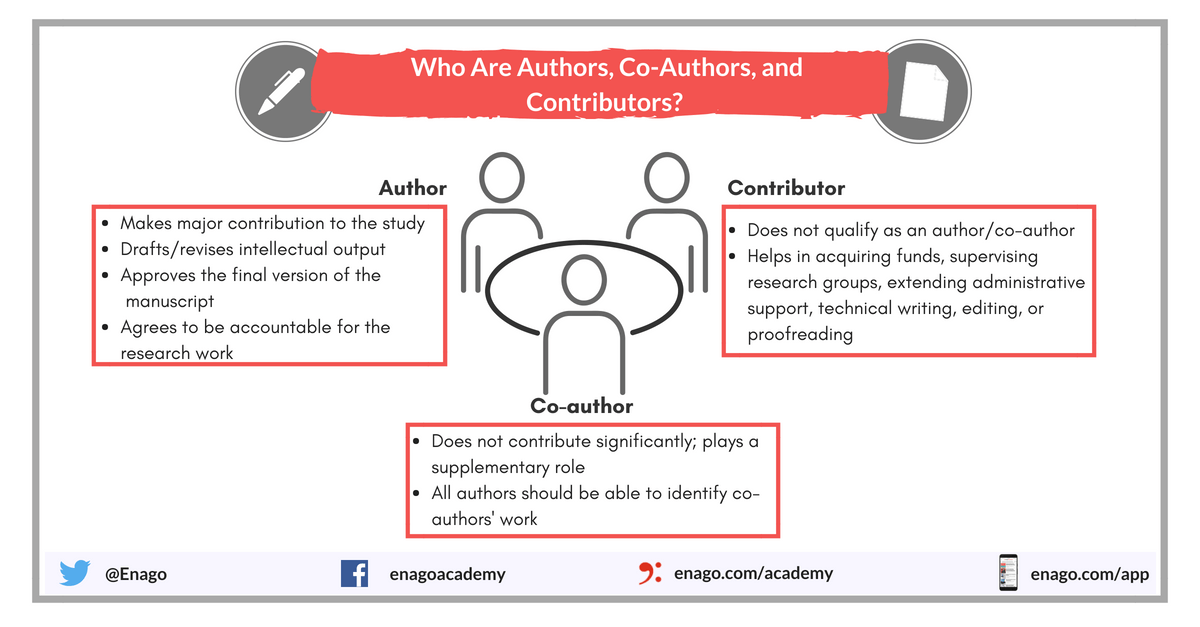Authorship: Difference Between “Contributor” and “Co-Author”

With an increasing number of researchers and graduates chasing publication opportunities under the pressure of “publish or perish,” many are settling for participation in multiple author projects as the first step in building a track record of publications. Over time, the trend of multiple authorship has grown from 3–4 authors of a paper to 6 or more. As those numbers grow, the potential for confusion over responsibilities, accountabilities, and entitlements grows in parallel.
The term “multiple authorship” can be misleading, since the degree to which the workload is apportioned can depend on rank, experience, and expertise. Some participants will earn a place on the team solely on the basis of rank, with the hope that their presence will improve the team’s chances of getting accepted for publication in a prestigious journal. Others will be invited because they authored the original study design, provided the dataset for the study, or even provided the institutional research facilities.
Layers of Authorship
When there are only three or four members on a research paper team, the workload should be fairly easy to divide up, with a corresponding designation of one lead author and two or three co-authors. However, when the size of the team increases, a point is reached when co-authors become contributors. The perception of these titles can vary. New researchers who aspire to official authorship status may see the title of “contributor” as a relegation or demotion in rank, but for other, more experienced researchers, it may simply be a pragmatic recognition of the fact that you may have provided valuable resources but didn’t actually contribute to the writing or editing of the research paper.
Academic Misconduct
The danger in opening up another level of authorship is that journals are now given the opportunity to stuff papers with a few extra authors.
Related: Confused about assigning authorship to the right person? Check out this post on authorship now!
If the journal’s conduct has been flagged as being questionable to begin with—charging high article processing fees (APFs) for publication, delivering suspiciously short turnaround times for peer reviews—how far can they be from colluding with editors to add on a few contributors who had nothing to do with the research paper at all?

Contributorship Statements
As the development of larger research teams or collaborative authorship teams continues, the opportunities for new researchers to get published will hopefully increase too. However, the opportunity should never be looked upon as just getting your name added to the list of collaborators because being on that list comes with responsibilities. For example, if the peer review process flags problems with the data, who will be tasked with responding to that? If the reviewers request a partial re-write and re-submission, who will be tasked with delivering on those requests?
The larger the team, the greater the need for a detailed written agreement that allocates clear responsibilities both pre- and post-submission. This would fulfill two important tasks. First, everyone would know what is expected of them and what the consequences would be for not delivering on those expectations. Second, when the paper is accepted for publication, the agreement could be summarized as a contributorship statement, so that readers are given a clear picture of who did what. In addition, as this trend of multiple authorship continues, grant and tenure committees are starting to request clarification of publication claims, and such a statement would help to delineate precisely what you contributed to the paper.









Hello,
How to cite the article of Authorship: Difference Between “Contributor” and “Co-Author”?
Warm regards
Hi Atif,
Thank you for sharing your query on our website. Since we are not aware of the writing style format of the research paper concerned, we would suggest you to refer to the following website :https://www.citationmachine.net/apa/cite-a-website. Accordingly you can choose the style, add the article link and create the relevant citation format for the paper. Please note that proper acknowledgement and citation of the reference is necessary to avoid any issues of plagiarism.
Let us know in case of any other queries.
An impressive share! I’ve just forwarded this onto a coworker who was conducting a little research on this.
And he in fact ordered me breakfast simply because I stumbled upon it for him… lol. So allow me to reword this….
Thanks for the meal!! But yeah, thanks for spending some time
to talk about this issue here on your website.